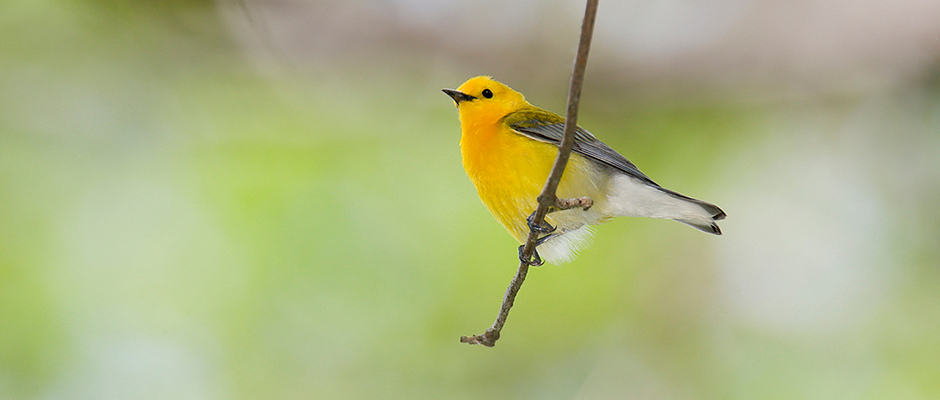Share this article
Where Do You Go, Little Warbler, When It Snows?
It was Christmas in late March for Erik Johnson and Jared Wolfe.
The two researchers had just received news that a Prothonotary warbler (Protonotaria citrea) that they had fitted with a geolocator in June 2013 had just returned to Baton Rouge, La. after its fall migration. They stopped what they were doing and bolted over to the nest boxes where volunteer scientists had heard the bird’s song “sweet sweet sweet!”
“I hadn’t had that feeling since Christmas when I was ten and wanted to see the presents under the tree,” said Wolfe, a wildlife ecologist at the U.S. Forest Service’s Pacific Southwest Research Station and lead author of a recent study on the species published in the Journal of Field Ornithology.
Soon after, they captured the little bright yellow bird — imagine the yellowest yellow, Johnson says, and make it twice as yellow — and retrieved the geolocator, a battery-powered data logger with light sensors that record sunrise and sunset daily. That data is then used to estimate the longitude and latitude of the birds. “We thought, ‘what were the odds that it would come back?’ And it did,” said Johnson, director of bird conservation at Audubon Louisiana and co-author of the study.
One Bird, Many Observations
Prothonotary warblers have faced a number of conservation challenges including decimation of their preferred breeding habitat due to conversions of lowland forest to farmland, Wolfe said. In half of the 30 or so U.S. states in which Prothonotary warblers breed, they are considered vulnerable, imperiled or critically imperiled, according to Johnson. They’re identified as one of the top songbird species in decline, and their populations have dropped by over one percent per year in the last 50 years. “Their rates of decline are exceeding their rates of habitat loss on their breeding grounds,” Johnson said.
After retrieving the geolocator, the researchers uncovered a lot of previously unknown information about the brilliantly yellow warbler. “The most striking results of the study are that it adds to the growing body of evidence that some birds might have multiple wintering territories,” Wolfe said. With the advent of geolocator technology, there has been a record of birds going to one wintering area and then to a second one after some time, he said. This called into question the definition of stopover and overwintering behavior. For example, the geolocator estimates show that the bird went to the Greater Antilles in the Caribbean Sea for about one month before traveling again, which could either be classified as a prolonged stopover or a secondary wintering area.
The researchers also learned that it took the warbler three and a half months to get to the northwestern Colombia-Panama border and only three weeks to get back to Baton Rouge. Further, it traveled a minimum of 5,000 miles, went through seven countries, and made three 500 to 700-mile flights non-stop while going over water. “It’s remarkable when you think about the fact that that this is a little bird that weighs just over the weight of five pennies,” Johnson said.
Based on the knowledge that the bird had used prolonged stopover areas, Johnson stressed the importance of conserving stopover habitat and not just wintering habitat. Prothonotary warblers will have a harder time to make their migratory journeys if bits and pieces of stopover site disappear. “It’s like a chain with a bunch of links,” he said. “If one link breaks, the entire chain is broken and you lose that bird.”
Since this pilot study, geolocators have been placed on birds in four other states — Virginia, South Carolina, Arkansas and Ohio. In 2016, the researchers hope to further expand the project to determine whether birds from these states show similar migration patterns.
“Our endeavors might be precedent setting because we relied on community involvement and for local bird advocates to monitor nest boxes, which was necessary for a successful project,” Wolfe said. “We’re using nonprofit organizations and academic backgrounds to produce great science with conservation implications.”
Header Image: A Prothonotary warbler has bright yellow feathers and is also sometimes known as a yellow swamp canary.
Image Credit: Bill Majoros, licensed by cc 2.0








